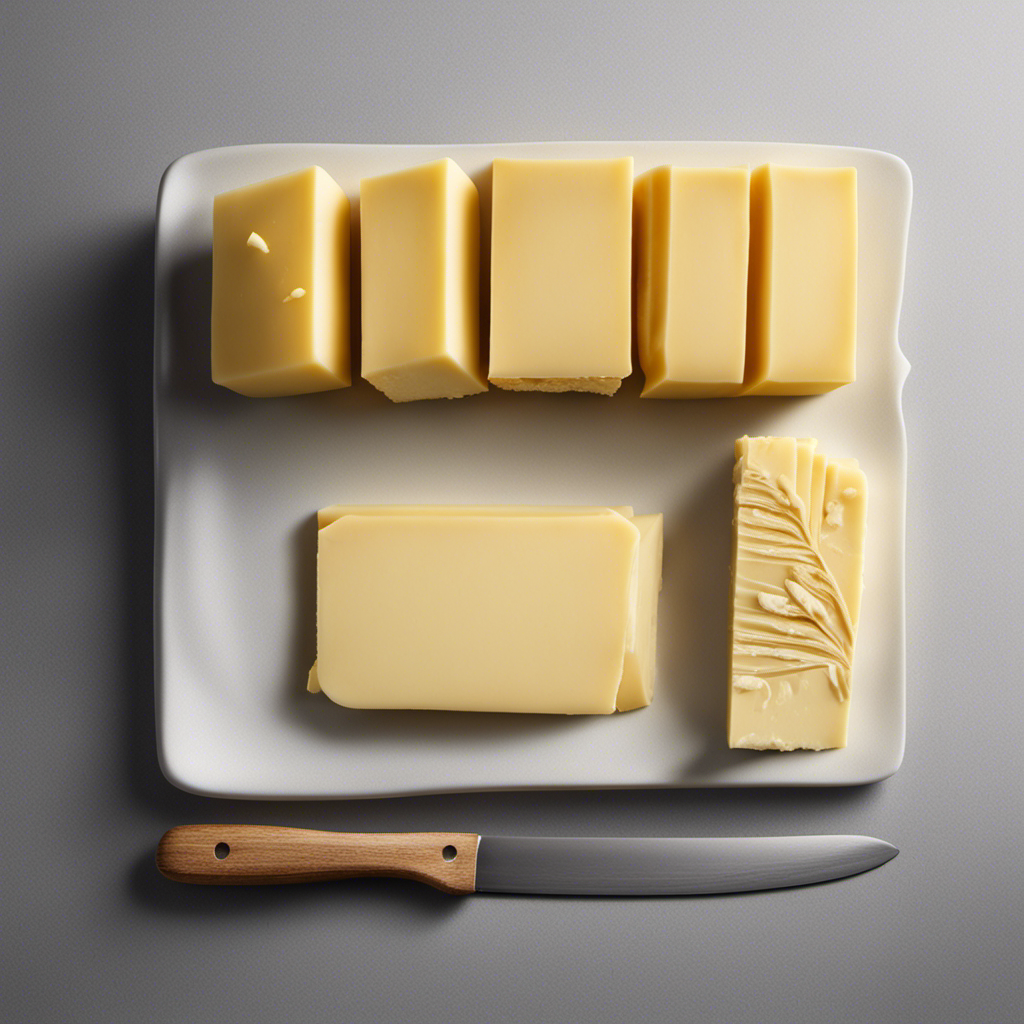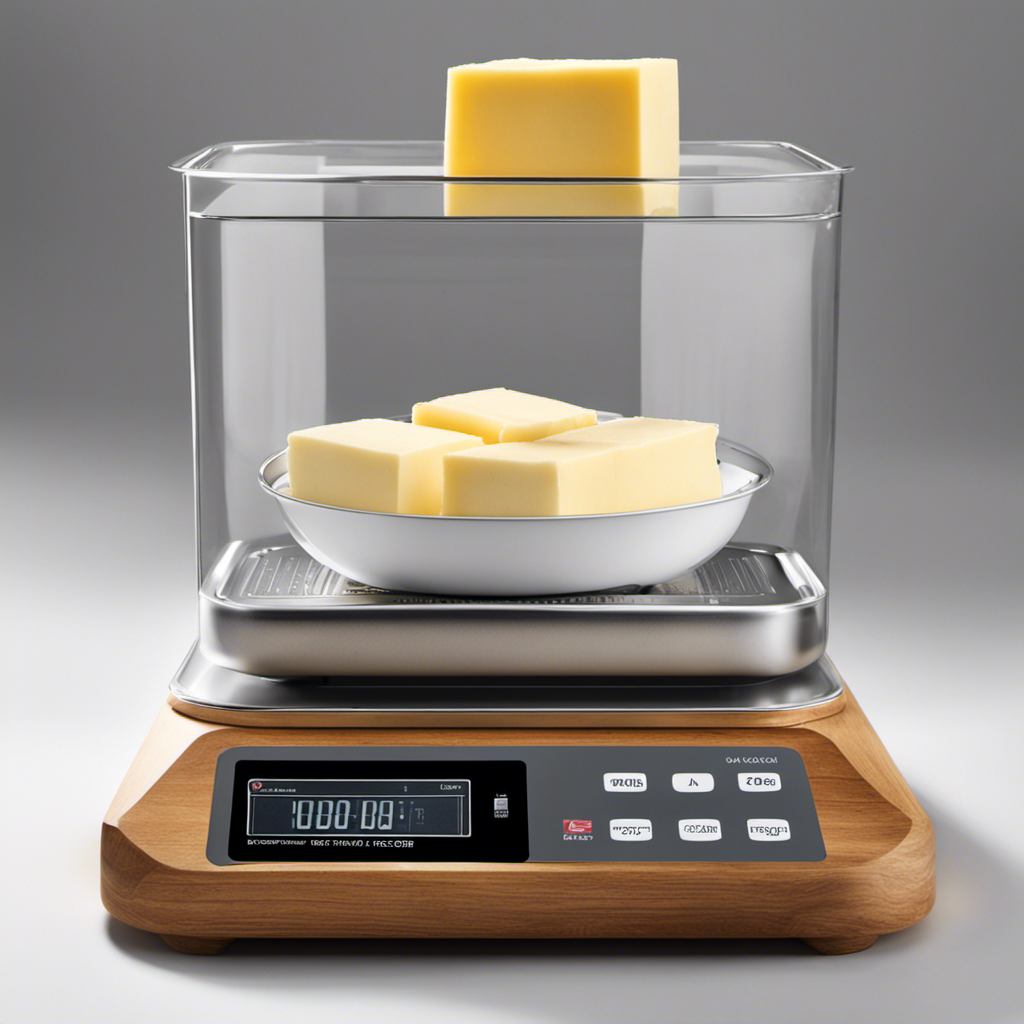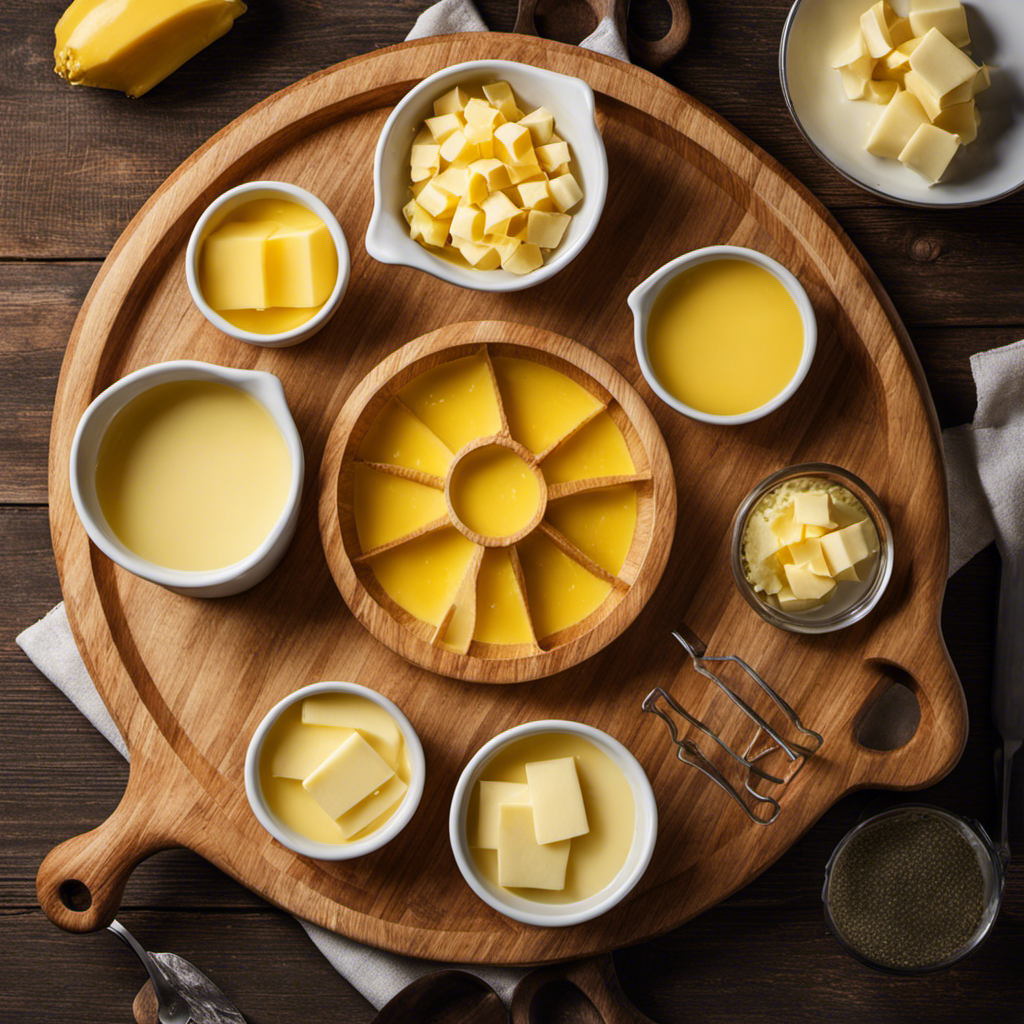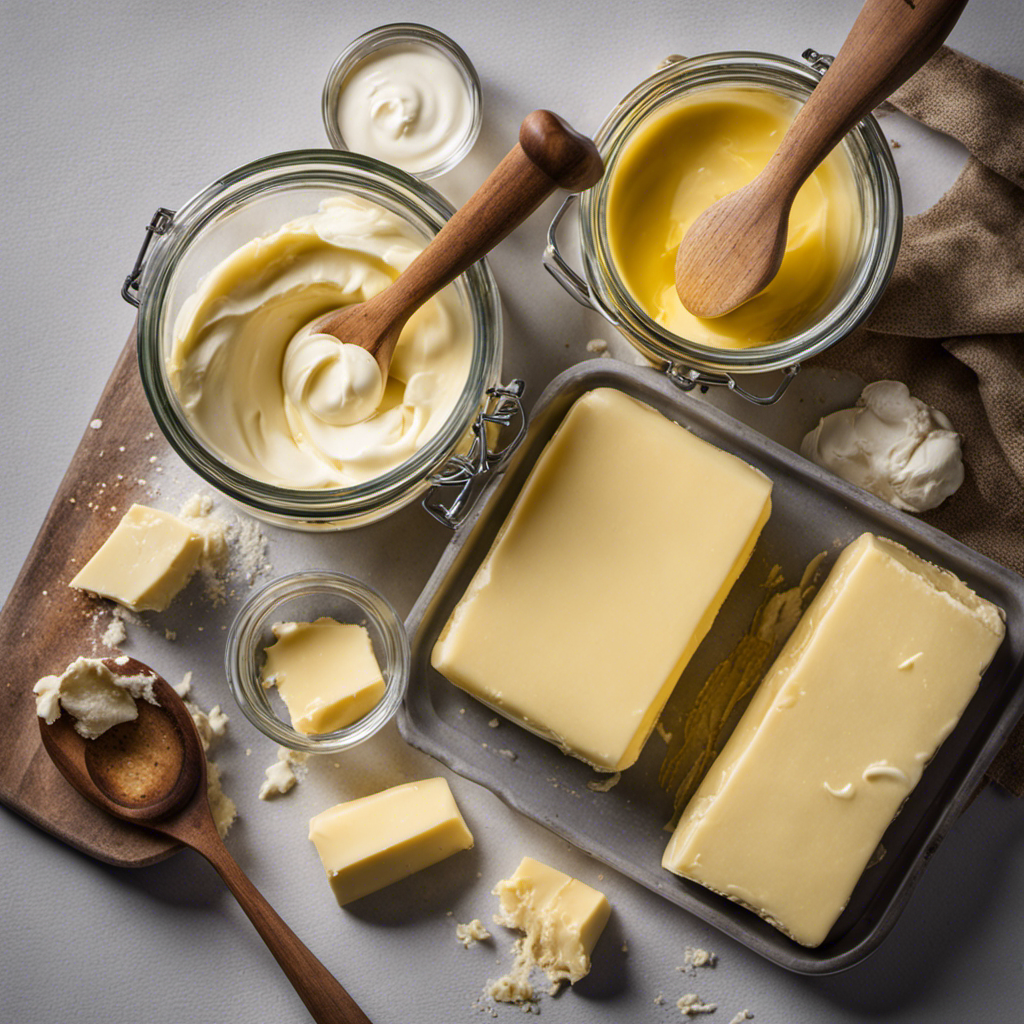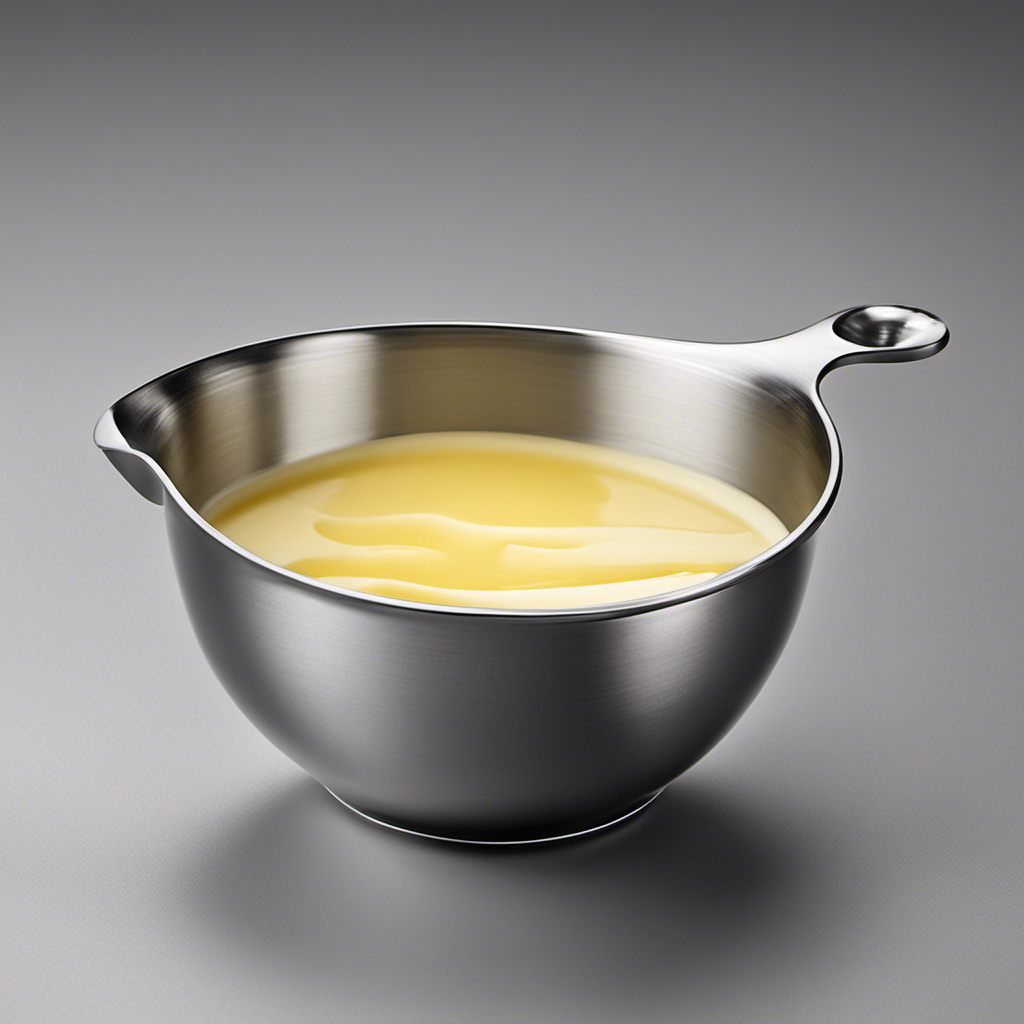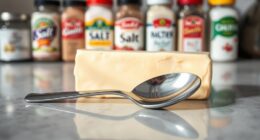I understand your concern – you may be thinking that butter is not good for you, am I right? However, let me assure you, there is more to the story than you may realize.
In this article, we’ll delve into the nutritional composition of butter and break down the grams of fat in a stick. We’ll compare butter to other fats and explore tips for measuring fat content.
Plus, we’ll discuss how to make healthier choices with butter and its impact on our health.
So, let’s dive in and unravel the truth about butter’s fat content.
Key Takeaways
- A stick of butter typically contains around 80 grams of fat.
- Butter has an average fat content of around 80%.
- Consuming excessive amounts of butter fat is associated with increased risk of heart disease and obesity.
- It is recommended to limit saturated fat intake to less than 10% of daily calories.
The Nutritional Composition of Butter
You can easily find the nutritional composition of butter by checking the label on the packaging. Understanding butter nutrition is important if you want to make informed choices about your diet.
One key aspect of butter nutrition is measuring butter fat. Butter is primarily composed of milk fat, which gives it its rich and creamy texture. The amount of fat in butter can vary depending on the brand and type of butter. Generally, a stick of butter contains around 80 grams of fat.
This high fat content makes butter a calorie-dense food. It is important to consume butter in moderation and balance it with other nutritious foods to maintain a healthy diet.
Understanding the Fat Content in Butter
When it comes to butter, understanding its fat content is crucial.
Butter is primarily composed of milk fat, with an average fat content of around 80%.
This high fat content can have significant health implications, as excessive consumption of butter fat has been associated with an increased risk of heart disease and obesity.
Butter Fat Content
To determine the fat content in a stick of butter, simply check the nutrition label. The amount of fat in butter can vary depending on the brand and type of butter. On average, a stick of butter contains about 11-12 grams of fat.
However, it is important to note that not all fats are equal. Butter is high in saturated fat, which is linked to an increased risk of heart disease. Monitoring fat intake is crucial for maintaining a healthy diet. It is recommended to limit saturated fat intake to less than 10% of daily calories.
In order to accurately measure fat intake, it is important to pay attention to serving sizes and the fat content of various food items.
Health Implications of Butter Fat
The health implications of butter fat vary depending on the amount consumed and individual dietary needs. While butter is often criticized for its high saturated fat content, it does offer some health benefits.
Butter is a good source of fat-soluble vitamins like A, D, E, and K, and it contains conjugated linoleic acid (CLA), which has been associated with potential health benefits such as reduced inflammation and improved body composition.
However, it’s important to consume butter in moderation due to its high calorie and saturated fat content. For those looking for alternatives to butter, options like olive oil, avocado, and nut butters can provide similar flavor and texture while offering healthier fats.
Now, let’s break down the grams of fat in a stick of butter.
Breaking Down the Grams of Fat in a Stick of Butter
If you’re curious, there are about 92 grams of fat in a stick of butter. Understanding the nutritional value of butter can help us make informed choices about our diet.
When comparing butter fat to other dairy products, it’s important to note that butter has a higher fat content than many other dairy products. Here are a few key points to consider:
- Butter contains more fat than milk, yogurt, and cheese.
- Butter fat is primarily composed of saturated fat, which can raise cholesterol levels.
- Butter is a good source of vitamin A, but it lacks other essential nutrients found in dairy products like calcium and protein.
- Moderation is key when consuming butter due to its high fat content.
Knowing how butter compares to other fats in terms of fat content can further guide our dietary decisions.
How Butter Compares to Other Fats in Terms of Fat Content
When comparing butter to oils, it is important to consider their fat content. Butter has a higher fat content compared to most oils, with approximately 80% fat.
In terms of fat content rankings, butter falls on the higher end, making it a more calorie-dense option. However, it is worth noting that the health implications of butter are still a topic of debate among experts, with some studies linking it to increased risk of heart disease.
Butter Vs Oils
Did you know that butter typically contains more saturated fat compared to oils? While butter has been a staple in many kitchens for years, it’s important to consider healthier alternatives when it comes to cooking with fats. Here are some reasons why you might want to explore other options:
- Butter alternatives offer a lower saturated fat content, making them a healthier choice.
- Oils like olive oil and avocado oil provide beneficial monounsaturated fats that promote heart health.
- Using oils can enhance the flavor of your dishes and add a unique taste profile.
- Oils have a higher smoke point, making them more suitable for high-heat cooking methods.
Considering these points, it’s worth exploring different butter alternatives when cooking. Now, let’s delve into the fat content rankings of various fats and understand how they compare.
Fat Content Rankings
In my previous discussion about the differences between butter and oils, we explored their various properties and uses. Now, let’s delve into the fat content of different types of butter and compare them. This fat content comparison is crucial for those who are conscious about their dietary intake.
To help visualize the differences, I have created a table below:
| Butter Type | Fat Content (per 100g) | Cholesterol Content (per 100g) |
|---|---|---|
| Unsalted | 81g | 215mg |
| Salted | 81g | 215mg |
| Whipped | 55g | 183mg |
| Margarine | 80g | 0mg |
| Vegan Butter | 80g | 0mg |
From the table, we can see that all types of butter have similar fat content, with unsalted and salted butter containing the highest amounts. It is important to note that butter is also high in cholesterol. For those concerned about their cholesterol intake, margarine and vegan butter may be better alternatives as they contain zero cholesterol.
Health Implications of Butter
To maintain a healthier diet, it’s important for you to be aware of the potential health implications that come with consuming butter. While butter is delicious, it is high in saturated fat and cholesterol, which can increase the risk of heart disease.
However, there are several alternatives to butter that can provide health benefits without sacrificing taste. Consider incorporating these options into your diet:
- Olive oil: Rich in monounsaturated fats, which can help lower bad cholesterol levels.
- Avocado: Contains healthy fats and is a great source of vitamins and minerals.
- Nut butter: Provides protein, healthy fats, and fiber.
- Greek yogurt: A versatile substitute that is low in fat and high in protein.
Tips for Measuring Fat Content in Butter
You can easily determine the fat content in butter by reading the nutrition label. When it comes to measuring fat content, it’s important to pay attention to the serving size. The nutrition label will provide the grams of fat per serving.
For example, a stick of butter typically weighs around 113 grams and contains about 81 grams of fat. This means that each tablespoon of butter contains approximately 11 grams of fat.
When comparing fat content between different brands or types of butter, reading the nutrition label is crucial. Some brands offer lower fat options, such as light or reduced-fat butter, which may have a lower fat content compared to regular butter.
How to Make Healthier Choices With Butter and Fat Intake
When making healthier choices with butter and fat intake, it’s important to consider alternative options that offer lower fat content. Switching to butter alternatives can help reduce saturated fat intake and promote a healthier lifestyle. Here are four options to consider:
-
Olive oil: This heart-healthy oil is rich in monounsaturated fats and can be used as a substitute for butter in cooking and baking.
-
Avocado: Mashed avocado can be used as a spread instead of butter on toast or sandwiches. It provides healthy fats and adds a creamy texture.
-
Greek yogurt: This versatile ingredient can be used in place of butter in recipes to reduce fat content. It adds moisture and creaminess to dishes.
-
Nut butters: Peanut, almond, or cashew butter can be used as a spread or in recipes to replace butter. They offer healthy fats and a delicious flavor.
The Role of Saturated Fat in Butter and Its Impact on Health
The role of saturated fat in butter is important to understand because it can have an impact on overall health.
Saturated fat is known to raise cholesterol levels, particularly low-density lipoprotein (LDL) cholesterol, which is often referred to as ‘bad’ cholesterol. High levels of LDL cholesterol are associated with an increased risk of heart disease and stroke.
Butter is a significant source of saturated fat, with approximately 7 grams of saturated fat per tablespoon. Therefore, consuming large amounts of butter can contribute to elevated cholesterol levels and potentially harm heart health.
It is recommended to limit saturated fat intake and choose healthier alternatives, such as olive oil or avocado, which are rich in monounsaturated and polyunsaturated fats that have been shown to have a positive impact on heart health.
Balancing Fat Intake With a Stick of Butter in Your Diet
Now that we understand the role of saturated fat in butter and its impact on health, let’s talk about how to balance fat intake when incorporating a stick of butter into our diet.
-
Portion control: It’s important to measure the amount of butter you use to ensure you’re not consuming excessive fat.
-
Consider the recipe: Some recipes may require less butter or can be modified to use healthier alternatives, such as olive oil or avocado.
-
Pair with healthier options: Instead of slathering butter on bread, consider pairing it with nutritious foods like whole-grain toast or steamed vegetables.
-
Moderation is key: While butter can be enjoyed in moderation, it’s essential to balance your overall fat intake throughout the day and opt for healthier fats from sources like nuts, seeds, and avocados.
Frequently Asked Questions
How Many Calories Are in a Stick of Butter?
There are approximately 814 calories in a stick of butter. Butter has a high fat content, with each gram of fat providing 9 calories. It’s important to consume butter in moderation to maintain a balanced diet.
Does the Fat Content in Butter Vary Between Different Brands?
Butter from grass-fed cows may have a higher fat content. The recommended daily intake of saturated fat from butter is about 20 grams. Different brands of butter may vary in fat content.
What Are the Different Types of Fat Found in Butter?
Different types of fat in butter include saturated fat, monounsaturated fat, and polyunsaturated fat. Butter is also a good source of vitamins A, D, E, and K. Its nutritional value depends on the brand and type of butter.
Can the Fat Content in Butter Be Reduced by Using Low-Fat or Margarine Alternatives?
Using low-fat butter options can reduce the fat content in butter. However, the health effects of margarine are debatable. It’s important to read labels and choose options with lower saturated and trans fats.
Are There Any Health Benefits Associated With Consuming Butter in Moderation?
In moderation, butter can add flavor to meals. However, it is essential to be mindful of its fat content. While it may not offer significant health benefits, it does provide small amounts of vitamins A, D, and E.
Conclusion
In conclusion, after delving into the fascinating world of butter and its fat content, it is mind-blowing to realize just how many grams of fat are packed into a single stick of this creamy delight.
With its rich and decadent nature, it’s no wonder that butter has become a staple in many dishes. However, it’s important to be mindful of our fat intake and make healthier choices when it comes to our diet.
So, while a stick of butter may seem innocent, remember that moderation is key to achieving a balanced and nutritious lifestyle.
